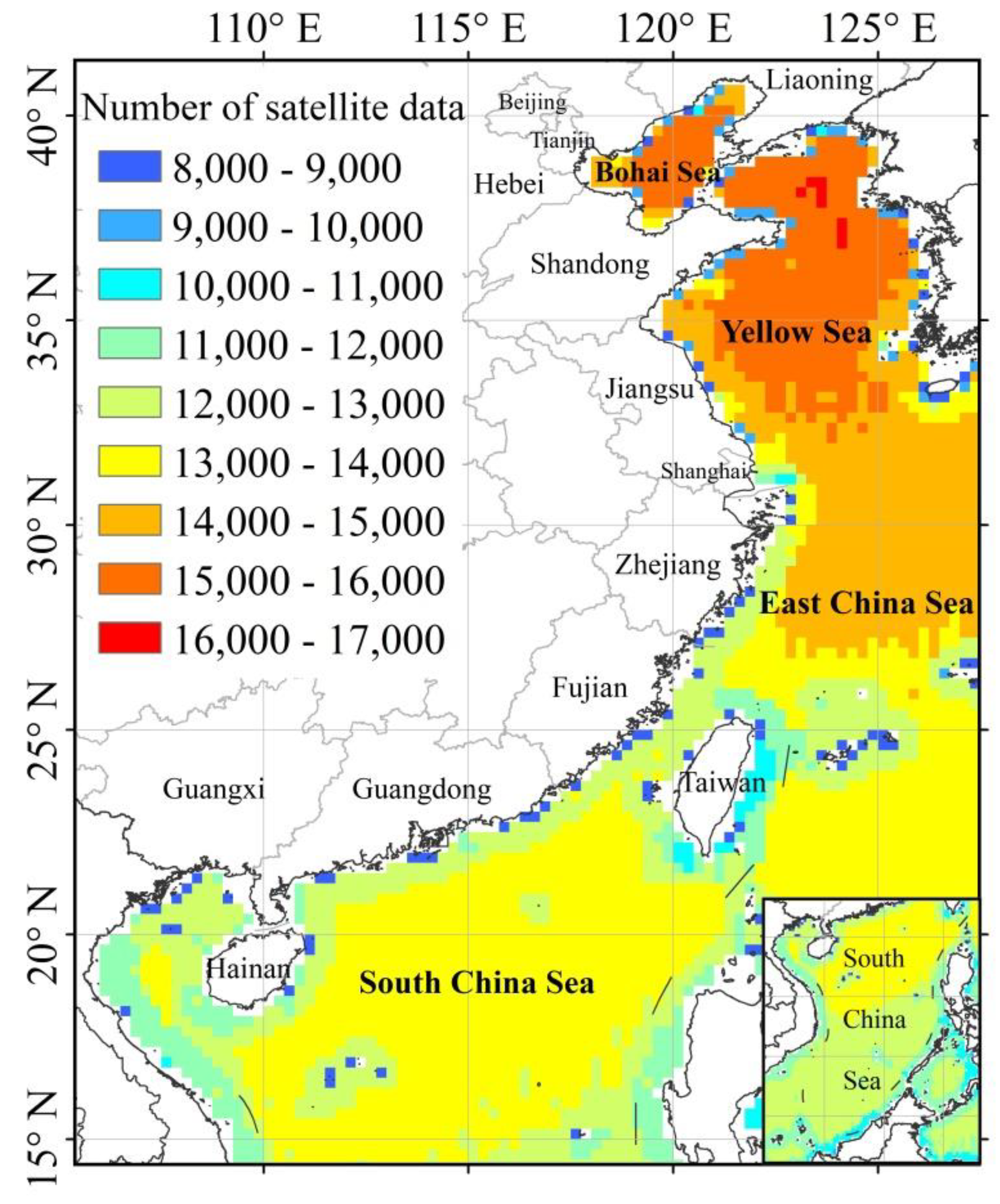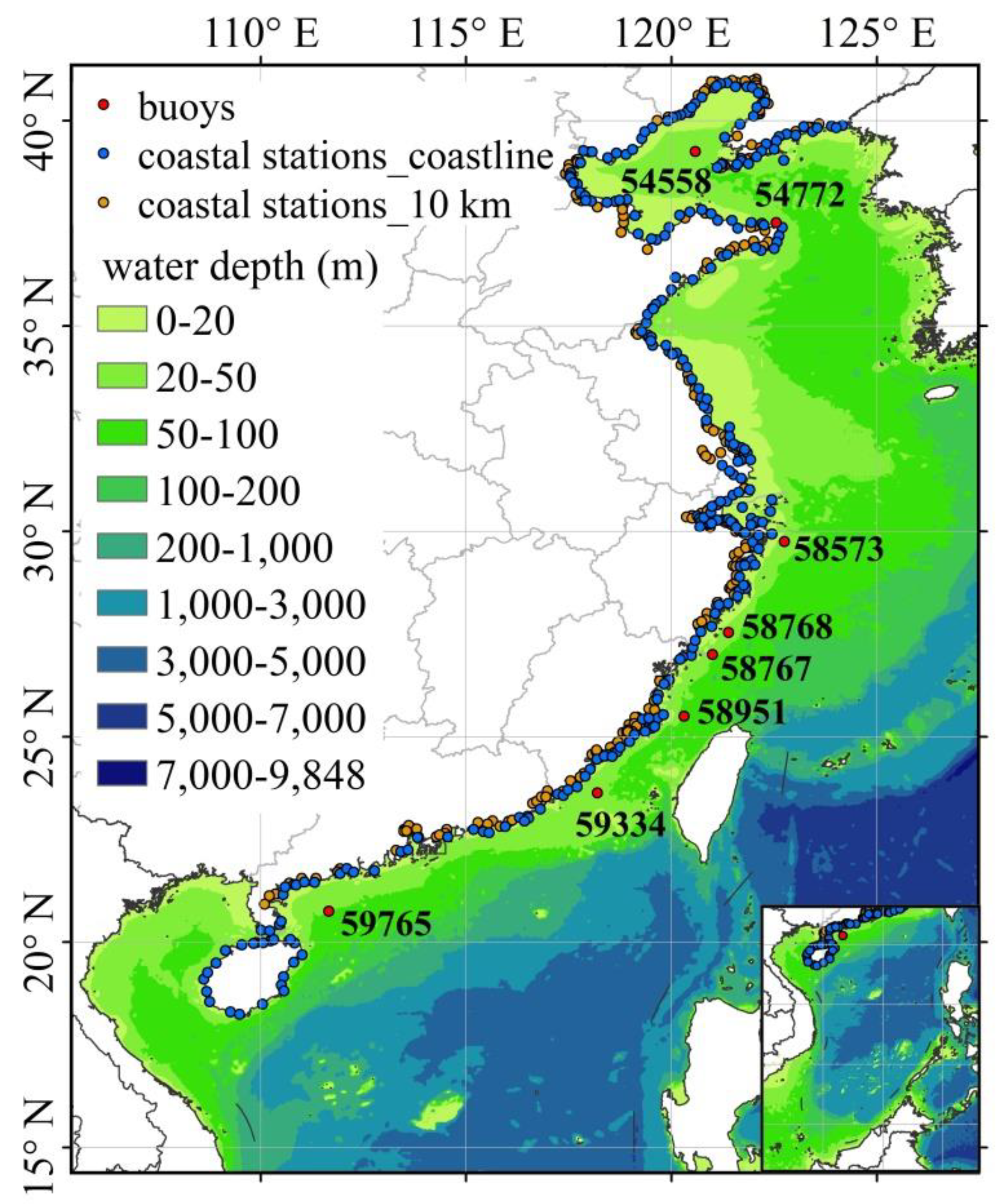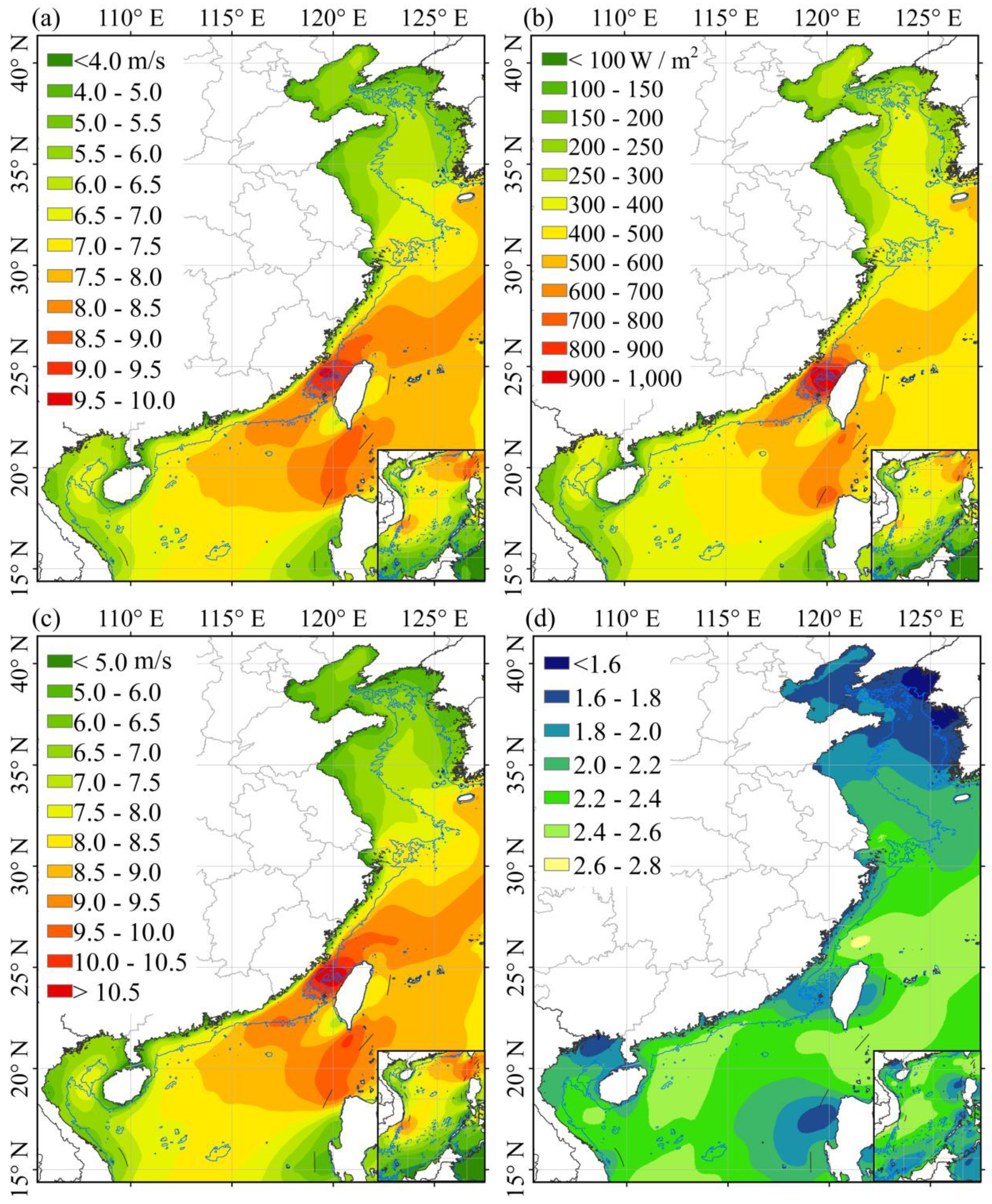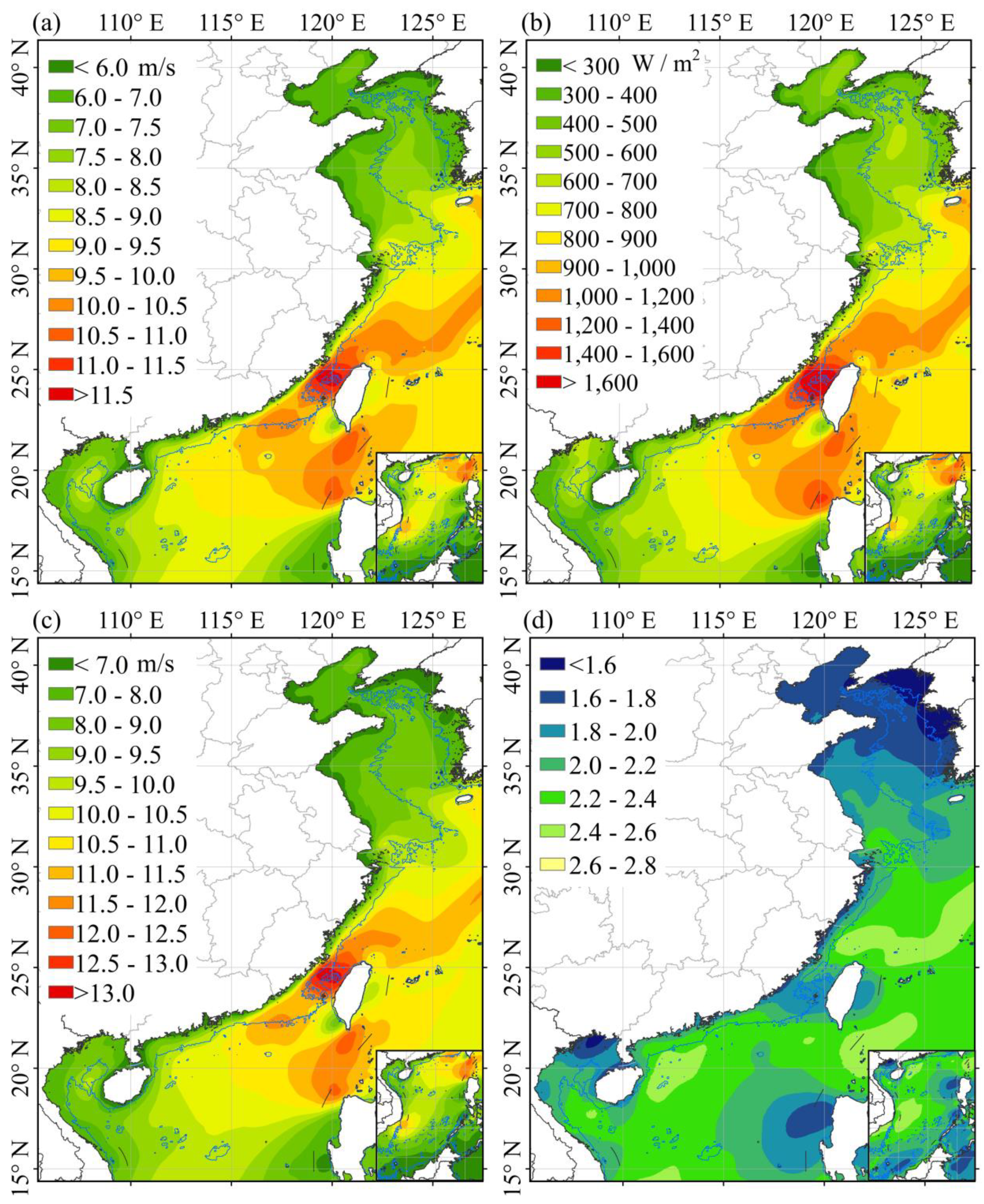Assessment of China’s Offshore Wind Resources Based on the Integration of Multiple Satellite Data and Meteorological Data
Abstract
1. Introduction
2. Data
2.1. Satellite Data
2.2. Meteorological Data
2.3. Elevation and Bathymetric Data
3. Methods
3.1. Extrapolating Wind Speed to Hub Height
3.2. Wind Resources Assessment Method
4. Results
4.1. Validation of Interpolated MWS and WPD
4.2. Validation of Interpolated Weibull Parameters
4.3. Spatial Variability of Interpolated Offshore Wind Resources over the China Sea
5. Discussion
6. Conclusions
Author Contributions
Funding
Acknowledgments
Conflicts of Interest
References
- Global Wind Report 2018. Available online: https://gwec.net/wp-content/uploads/2019/04/GWEC-Global-Wind-Report-2018.pdf (accessed on 10 November 2019).
- Zheng, C.W.; Li, C.Y.; Pan, J.; Liu, M.Y.; Xia, L.L. An overview of global ocean wind energy resource evaluations. Renew. Sustain. Energy Rev. 2016, 53, 1240–1251. [Google Scholar] [CrossRef]
- Jiang, D.; Zhuang, D.; Huang, Y.; Wang, J.; Fu, J. Evaluating the spatio-temporal variation of China’s offshore wind resources based on remotely sensed wind field data. Renew. Sustain. Energy Rev. 2013, 24, 142–148. [Google Scholar] [CrossRef]
- Sahin, B.; Bilgili, M.; Akilli, H. The wind power potential of the eastern Mediterranean region of Turkey. J. Wind. Eng. Ind. Aerodyn. 2005, 93, 171–183. [Google Scholar] [CrossRef]
- Dhanju, A.; Whitaker, P.; Kempton, W. Assessing offshore wind resources: An accessible methodology. Renew. Energy 2008, 33, 55–64. [Google Scholar] [CrossRef]
- Ucar, A.; Balo, F. Assessment of wind power potential for turbine installation in coastal areas of Turkey. Renew. Sustain. Energy Rev. 2010, 14, 1901–1912. [Google Scholar] [CrossRef]
- Oh, K.Y.; Kim, J.Y.; Lee, J.K.; Ryu, M.S.; Lee, J.S. An assessment of wind energy potential at the demonstration offshore wind farm in Korea. Energy 2012, 46, 555–563. [Google Scholar] [CrossRef]
- Sheridan, B.; Baker, S.D.; Pearre, N.S.; Firestone, J.; Kempton, W. Calculating the offshore wind power resource: Robust assessment methods applied to the U.S. Atlantic Coast. Renew. Energy 2012, 43, 224–233. [Google Scholar] [CrossRef]
- Akpınar, A. Evaluation of wind energy potentiality at coastal locations along the north eastern coasts of Turkey. Energy 2013, 50, 395–405. [Google Scholar] [CrossRef]
- Gao, X.; Yang, H.; Lu, L. Study on offshore wind power potential and wind farm optimization in Hong Kong. Appl. Energy 2014, 130, 519–531. [Google Scholar] [CrossRef]
- Kucukali, S.; Dinçkal, Ç. Wind energy resource assessment of Izmit in the West Black Sea Coastal Region of Turkey. Renew. Sustain. Energy Rev. 2014, 30, 790–795. [Google Scholar] [CrossRef]
- Shu, Z.; Li, Q.; Chan, P. Investigation of offshore wind energy potential in Hong Kong based on Weibull distribution function. Appl. Energy 2015, 156, 362–373. [Google Scholar] [CrossRef]
- Fichaux, N.; Poglio, T.; Ranchin, T. Mapping Offshore Wind Resources: Synergetic Potential of SAR and Scatterometer Data. IEEE J. Ocean. Eng. 2005, 30, 516–525. [Google Scholar] [CrossRef]
- Hasager, C.B.; Nielsen, M.; Astrup, P.; Barthelmie, R.J.; Dellwik, E.; Jensen, N.O.; Jørgensen, B.H.; Pryor, S.C.; Rathmann, O.; Furevik, B.R. Offshore wind resource estimation from satellite SAR wind field maps. Wind. Energy 2005, 8, 403–419. [Google Scholar] [CrossRef]
- Christiansen, M.B.; Koch, W.; Horstmann, J.; Hasager, C.B.; Nielsen, M. Wind resource assessment from C-band SAR. Remote. Sens. Environ. 2006, 105, 68–81. [Google Scholar] [CrossRef]
- Beaucage, P.; Bernier, M.; Lafrance, G.; Choisnard, J. Regional Mapping of the Offshore Wind Resource: Towards a Significant Contribution From Space-Borne Synthetic Aperture Radars. IEEE J. Sel. Top. Appl. Earth Obs. Remote. Sens. 2008, 1, 48–56. [Google Scholar] [CrossRef]
- Hasager, C.B.; Pena, A.; Christiansen, M.B.; Astrup, P.; Nielsen, M.; Monaldo, F.; Thompson, D.; Nielsen, P. Remote Sensing Observation Used in Offshore Wind Energy. IEEE J. Sel. Top. Appl. Earth Obs. Remote. Sens. 2008, 1, 67–79. [Google Scholar] [CrossRef]
- Badger, M.; Badger, J.; Nielsen, M.; Hasager, C.B.; Peña, A. Wind Class Sampling of Satellite SAR Imagery for Offshore Wind Resource Mapping. J. Appl. Meteorol. Clim. 2010, 49, 2474–2491. [Google Scholar] [CrossRef]
- Beaucage, P.; Lafrance, G.; Lafrance, J.; Choisnard, J.; Bernier, M. Synthetic aperture radar satellite data for offshore wind assessment: A strategic sampling approach. J. Wind. Eng. Ind. Aerodyn. 2011, 99, 27–36. [Google Scholar] [CrossRef]
- Hasager, C.B.; Badger, M.; Peña, A.; Larsén, X.G.; Bingöl, F. SAR-Based Wind Resource Statistics in the Baltic Sea. Remote. Sens. 2011, 3, 117–144. [Google Scholar] [CrossRef]
- Chang, R.; Zhu, R.; Badger, M.; Hasager, C.B.; Zhou, R.; Ye, D.; Zhang, X. Applicability of Synthetic Aperture Radar Wind Retrievals on Offshore Wind Resources Assessment in Hangzhou Bay, China. Energies 2014, 7, 3339–3354. [Google Scholar] [CrossRef]
- Monaldo, F.M.; Li, X.; Pichel, W.G.; Jackson, C.R. Ocean Wind Speed Climatology from Spaceborne SAR Imagery. Bull. Am. Meteorol. Soc. 2014, 95, 565–569. [Google Scholar] [CrossRef]
- Chang, R.; Zhu, R.; Badger, M.; Hasager, C.B.; Xing, X.; Jiang, Y. Offshore Wind Resources Assessment from Multiple Satellite Data and WRF Modeling over South China Sea. Remote. Sens. 2015, 7, 467–487. [Google Scholar] [CrossRef]
- Hasager, C.B.; Mouche, A.; Badger, M.; Bingöl, F.; Karagali, I.; Driesenaar, T.; Stoffelen, A.; Peña, A.; Longépé, N. Offshore wind climatology based on synergetic use of Envisat ASAR, ASCAT and QuikSCAT. Remote Sens. Environ. 2015, 156, 247–263. [Google Scholar] [CrossRef]
- Risien, C.M.; Chelton, D.B. A satellite-derived climatology of global ocean winds. Remote. Sens. Environ. 2006, 105, 221–236. [Google Scholar] [CrossRef]
- Liu, W.T.; Tang, W.; Xie, X. Wind power distribution over the ocean. Geophys. Res. Lett. 2008, 35, 1–6. [Google Scholar] [CrossRef]
- Pimenta, F.; Kempton, W.; Garvine, R. Combining meteorological stations and satellite data to evaluate the offshore wind power resource of Southeastern Brazil. Renew. Energy 2008, 33, 2375–2387. [Google Scholar] [CrossRef]
- Capps, S.B.; Zender, C.S. Global ocean wind power sensitivity to surface layer stability. Geophys. Res. Lett. 2009, 36, 1–5. [Google Scholar] [CrossRef]
- Capps, S.B.; Zender, C.S. Estimated global ocean wind power potential from QuikSCAT observations, accounting for turbine characteristics and siting. J. Geophys. Res. Space Phys. 2010, 115, 1–13. [Google Scholar] [CrossRef]
- Furevik, B.R.; Sempreviva, A.M.; Cavaleri, L.; Lefèvre, J.-M.; Transerici, C. Eight years of wind measurements from scatterometer for wind resource mapping in the Mediterranean Sea. Wind Energy 2011, 14, 355–372. [Google Scholar] [CrossRef]
- Karamanis, D.; Tsabaris, C.; Stamoulis, K.; Georgopoulos, D. Wind energy resources in the Ionian Sea. Renew. Energy 2011, 36, 815–822. [Google Scholar] [CrossRef]
- Oh, K.Y.; Kim, J.Y.; Lee, J.S.; Ryu, K.W. Wind resource assessment around Korean Peninsula for feasibility study on 100 MW class offshore wind farm. Renew. Energy 2012, 42, 217–226. [Google Scholar] [CrossRef]
- Karagali, I.; Badger, M.; Hahmann, A.N.; Peña, A.; Hasager, C.B.; Sempreviva, A.M. Spatial and temporal variability of winds in the Northern European Seas. Renew. Energy 2013, 57, 200–210. [Google Scholar] [CrossRef]
- Bentamy, A.; Croizé-Fillon, D. Spatial and temporal characteristics of wind and wind power off the coasts of Brittany. Renew. Energy 2014, 66, 670–679. [Google Scholar] [CrossRef]
- Karagali, I.; Peña, A.; Badger, M.; Hasager, C.B. Wind characteristics in the North and Baltic Seas from the QuikSCAT satellite. Wind Energy 2014, 17, 123–140. [Google Scholar] [CrossRef]
- Doubrawa, P.; Barthelmie, R.J.; Pryor, S.C.; Hasager, C.B.; Badger, M.; Karagali, I. Satellite winds as a tool for offshore wind resource assessment: The Great Lakes Wind Atlas. Remote. Sens. Environ. 2015, 168, 349–359. [Google Scholar] [CrossRef]
- Gadad, S.; Deka, P.C.; Gadad, D.S. Offshore wind power resource assessment using Oceansat-2 scatterometer data at a regional scale. Appl. Energy 2016, 176, 157–170. [Google Scholar] [CrossRef]
- Carvalho, D.; Rocha, A.; Gómez-Gesteira, M.; Santos, C.S. Offshore winds and wind energy production estimates derived from ASCAT, OSCAT, numerical weather prediction models and buoys – A comparative study for the Iberian Peninsula Atlantic coast. Renew. Energy 2017, 102, 433–444. [Google Scholar] [CrossRef]
- Guo, Q.; Xu, X.; Zhang, K.; Li, Z.; Huang, W.; Mansaray, L.R.; Liu, W.; Wang, X.; Gao, J.; Huang, J. Assessing Global Ocean Wind Energy Resources Using Multiple Satellite Data. Remote. Sens. 2018, 10, 100. [Google Scholar] [CrossRef]
- Wei, X.; Duan, Y.; Liu, Y.; Jin, S.; Sun, C. Onshore-offshore wind energy resource evaluation based on synergetic use of multiple satellite data and meteorological stations in Jiangsu Province, China. Front. Earth Sci. 2018, 13, 132–150. [Google Scholar] [CrossRef]
- Atlas, R.; Hoffman, R.N.; Bloom, S.C.; Jusem, J.C.; Ardizzone, J. A Multiyear Global Surface Wind Velocity Dataset Using SSM/I Wind Observations. Bull. Am. Meteorol. Soc. 1996, 77, 869–882. [Google Scholar] [CrossRef]
- Hasager, C.B.; Astrup, P.; Zhu, R.; Chang, R.; Badger, M.; Hahmann, A.N. Quarter-Century Offshore Winds from SSM/I and WRF in the North Sea and South China Sea. Remote. Sens. 2016, 8, 769. [Google Scholar] [CrossRef]
- Barthelmie, R.J.; Pryor, S.C. Can Satellite Sampling of Offshore Wind Speeds Realistically Represent Wind Speed Distributions? J. Appl. Meteorol. 2003, 42, 83–94. [Google Scholar] [CrossRef]
- Luo, W.; Taylor, M.C.; Parker, S.R. A comparison of spatial interpolation methods to estimate continuous wind speed surfaces using irregularly distributed data from England and Wales. Int. J. Clim. 2008, 28, 947–959. [Google Scholar] [CrossRef]
- Hernandez-Escobedo, Q.; Saldaña-Flores, R.; Rodríguez-García, E.; Manzano-Agugliaro, F. Wind energy resource in Northern Mexico. Renew. Sustain. Energy Rev. 2014, 32, 890–914. [Google Scholar] [CrossRef]
- Gonzalez-Longatt, F.; Medina, H.; González, J.S. Spatial interpolation and orographic correction to estimate wind energy resource in Venezuela. Renew. Sustain. Energy Rev. 2015, 48, 1–16. [Google Scholar] [CrossRef]
- Park, J.; Jang, D.-H. Application of MK-PRISM for interpolation of wind speed and comparison with co-kriging in South Korea. GIScience Remote. Sens. 2016, 53, 421–443. [Google Scholar] [CrossRef]
- Apaydin, H.; Sonmez, F.; Yildirim, Y. Spatial interpolation techniques for climate data in the GAP region in Turkey. Clim. Res. 2004, 28, 31–40. [Google Scholar] [CrossRef]
- Remote Sensing Systems. Available online: http://www.remss.com/missions (accessed on 21 August 2018).
- Zhang, Z.; Cao, Y.; Liu, T.; Zhao, W. Preliminary validation and application of ASCAT scatterometer retrieved winds over China offshore seas. Meteorol. Mon. 2014, 40, 473–481. [Google Scholar]
- Badger, M.; Peña, A.; Hahmann, A.N.; Mouche, A.A.; Hasager, C.B. Extrapolating Satellite Winds to Turbine Operating Heights. J. Appl. Meteorol. Clim. 2016, 55, 975–991. [Google Scholar] [CrossRef]
- Ren, G.; Wan, J.; Liu, J.; Yu, D. Characterization of wind resource in China from a new perspective. Energy 2019, 167, 994–1010. [Google Scholar] [CrossRef]
- Zheng, C.W.; Pan, J. Assessment of the global ocean wind energy resource. Renew. Sustain. Energy Rev. 2014, 33, 382–391. [Google Scholar] [CrossRef]
- Jung, C.; Schindler, D. The role of air density in wind energy assessment – A case study from Germany. Energy 2019, 171, 385–392. [Google Scholar] [CrossRef]
- Ulazia, A.; Sáenz, J.; Ibarra-Berastegi, G.; González-Rojí, S.J.; Carreno-Madinabeitia, S.; Ibarra-Berastegui, G. Global estimations of wind energy potential considering seasonal air density changes. Energy 2019, 187, 115938. [Google Scholar] [CrossRef]
- Gryning, S.E.; Floors, R.; Peña, A.; Batchvarova, E.; Brümmer, B. Weibull wind-speed distribution parameters derived from a combination of wind-Lidar and tall-mast measurements over land, coastal and marine sites. Bound.-Layer Meteor. 2016, 159, 329–348. [Google Scholar] [CrossRef]
- Liu, Y.; Chen, D.; Li, S.; Chan, P. Discerning the spatial variations in offshore wind resources along the coast of China via dynamic downscaling. Energy 2018, 160, 582–596. [Google Scholar] [CrossRef]
- Nie, B.; Li, J. Technical potential assessment of offshore wind energy over shallow continent shelf along China coast. Renew. Energy 2018, 128, 391–399. [Google Scholar] [CrossRef]
- Li, D.; Geyer, B.; Bisling, P. A model-based climatology analysis of wind power resources at 100-m height over the Bohai Sea and the Yellow Sea. Appl. Energy 2016, 179, 575–589. [Google Scholar] [CrossRef]
- Fang, H.-F. Wind energy potential assessment for the offshore areas of Taiwan west coast and Penghu Archipelago. Renew. Energy 2014, 67, 237–241. [Google Scholar] [CrossRef]
- Zheng, C.W.; Pan, J.; Li, J.X. Assessing the China Sea wind energy and wave energy resources from 1988 to 2009. Ocean Eng. 2013, 65, 39–48. [Google Scholar] [CrossRef]




| Buoy | Water Depth (m) | Distance to Coastline (km) | Time of Datasets | Number of Measurements |
|---|---|---|---|---|
| 54558 | 33 | 59 | 01.2011–12.2011 | 8440 |
| 54772 | 33 | 12 | 01.2016–12.2016 | 8680 |
| 58573 | 27 | 35 | 01.2011–12.2012 | 16,231 |
| 58767 | 35 | 52 | 12.2015–11.2016 | 7586 |
| 58768 | 32 | 40 | 01.2012–12.2012 | 8482 |
| 58951 | 55 | 45 | 01.2017–12.2017 | 8489 |
| 59334 | 40 | 55 | 01.2016–12.2017 | 17,241 |
| 59765 | 48 | 86 | 01.2016–12.2017 | 16,396 |
| Dataset for Interpolation | Interpolation Method | RMSE (m/s) | MAE (m/s) | Bias (m/s) | Corr. |
|---|---|---|---|---|---|
| 480 meteorological data | IDW | 2.456 | 2.347 | −2.347 | 0.686 |
| OK | 2.078 | 1.919 | −1.919 | 0.608 | |
| OCK | 1.889 | 1.675 | −1.675 | 0.551 | |
| 270 meteorological data | IDW | 2.121 | 1.924 | −1.924 | 0.600 |
| OK | 1.749 | 1.593 | −1.593 | 0.692 | |
| OCK | 1.603 | 1.429 | −1.415 | 0.678 | |
| Satellite data | IDW | 0.235 | 0.199 | 0.049 | 0.976 |
| OK | 0.234 | 0.179 | 0.082 | 0.977 | |
| OCK | 0.230 | 0.178 | 0.081 | 0.977 | |
| Satellite + 480 meteorological data | IDW | 0.214 | 0.177 | 0.054 | 0.980 |
| OK | 0.188 | 0.153 | 0.002 | 0.988 | |
| OCK | 0.202 | 0.160 | −0.004 | 0.984 | |
| Satellite + 270 meteorological data | IDW | 0.206 | 0.166 | 0.064 | 0.981 |
| OK | 0.177 | 0.132 | 0.076 | 0.987 | |
| OCK | 0.170 | 0.129 | 0.065 | 0.987 |
| Dataset for Interpolation | Interpolation Method | RMSE (W/m2) | MAE (W/m2) | Bias (W/m2) | Corr. |
|---|---|---|---|---|---|
| 480 meteorological data | IDW | 266.93 | 239.37 | −239.37 | 0.689 |
| OK | 240.19 | 208.97 | −208.97 | 0.705 | |
| OCK | 237.01 | 205.82 | −205.82 | 0.708 | |
| 270 meteorological data | IDW | 245.99 | 217.76 | −217.76 | 0.710 |
| OK | 227.32 | 197.56 | −196.45 | 0.730 | |
| OCK | 223.10 | 195.25 | −190.77 | 0.711 | |
| Satellite data | IDW | 36.47 | 28.08 | −15.96 | 0.992 |
| OK | 30.79 | 23.11 | −10.61 | 0.992 | |
| OCK | 30.63 | 23.00 | −11.10 | 0.992 | |
| Satellite + 480 meteorological data | IDW | 25.33 | 19.12 | −13.09 | 0.995 |
| OK | 24.98 | 20.11 | −14.98 | 0.996 | |
| OCK | 25.28 | 21.18 | −12.37 | 0.991 | |
| Satellite + 270 meteorological data | IDW | 24.95 | 17.94 | −11.10 | 0.996 |
| OK | 23.70 | 17.20 | −8.42 | 0.995 | |
| OCK | 23.38 | 16.88 | −8.45 | 0.995 |
| Dataset for Interpolation | Interpolation Method | RMSE (m/s) | MAE (m/s) | Bias (m/s) | Corr. |
|---|---|---|---|---|---|
| 480 meteorological data | IDW | 2.793 | 2.669 | −2.669 | 0.689 |
| OK | 2.359 | 2.178 | −2.178 | 0.607 | |
| OCK | 2.146 | 1.901 | −1.901 | 0.549 | |
| 270 meteorological data | IDW | 2.416 | 2.190 | −2.190 | 0.596 |
| OK | 1.994 | 1.816 | −1.816 | 0.690 | |
| OCK | 1.824 | 1.629 | −1.610 | 0.677 | |
| Satellite data | IDW | 0.286 | 0.241 | 0.062 | 0.971 |
| OK | 0.289 | 0.221 | 0.101 | 0.972 | |
| OCK | 0.285 | 0.219 | 0.098 | 0.972 | |
| Satellite + 480 meteorological data | IDW | 0.263 | 0.217 | 0.067 | 0.976 |
| OK | 0.237 | 0.178 | 0.006 | 0.984 | |
| OCK | 0.240 | 0.180 | 0.004 | 0.983 | |
| Satellite + 270 meteorological data | IDW | 0.256 | 0.205 | 0.079 | 0.977 |
| OK | 0.214 | 0.160 | 0.082 | 0.985 | |
| OCK | 0.214 | 0.161 | 0.080 | 0.985 |
| Dataset for Interpolation | Interpolation Method | RMSE | MAE | Bias | Corr. |
|---|---|---|---|---|---|
| 480 meteorological data | IDW | 0.335 | 0.292 | −0.253 | 0.375 |
| OK | 0.322 | 0.279 | −0.223 | 0.211 | |
| OCK | 0.298 | 0.252 | −0.195 | 0.302 | |
| 270 meteorological data | IDW | 0.325 | 0.281 | −0.238 | 0.367 |
| OK | 0.323 | 0.283 | −0.223 | 0.201 | |
| OCK | 0.286 | 0.238 | −0.201 | 0.556 | |
| Satellite data | IDW | 0.174 | 0.160 | 0.115 | 0.852 |
| OK | 0.178 | 0.160 | 0.112 | 0.832 | |
| OCK | 0.181 | 0.166 | 0.122 | 0.843 | |
| Satellite + 480 meteorological data | IDW | 0.163 | 0.149 | 0.104 | 0.866 |
| OK | 0.157 | 0.142 | 0.098 | 0.873 | |
| OCK | 0.156 | 0.140 | 0.097 | 0.873 | |
| Satellite + 270 meteorological data | IDW | 0.165 | 0.151 | 0.106 | 0.861 |
| OK | 0.164 | 0.149 | 0.105 | 0.862 | |
| OCK | 0.163 | 0.148 | 0.104 | 0.861 |
© 2019 by the authors. Licensee MDPI, Basel, Switzerland. This article is an open access article distributed under the terms and conditions of the Creative Commons Attribution (CC BY) license (http://creativecommons.org/licenses/by/4.0/).
Share and Cite
Guo, Q.; Huang, R.; Zhuang, L.; Zhang, K.; Huang, J. Assessment of China’s Offshore Wind Resources Based on the Integration of Multiple Satellite Data and Meteorological Data. Remote Sens. 2019, 11, 2680. https://doi.org/10.3390/rs11222680
Guo Q, Huang R, Zhuang L, Zhang K, Huang J. Assessment of China’s Offshore Wind Resources Based on the Integration of Multiple Satellite Data and Meteorological Data. Remote Sensing. 2019; 11(22):2680. https://doi.org/10.3390/rs11222680
Chicago/Turabian StyleGuo, Qiaoying, Ran Huang, Liwei Zhuang, Kangyu Zhang, and Jingfeng Huang. 2019. "Assessment of China’s Offshore Wind Resources Based on the Integration of Multiple Satellite Data and Meteorological Data" Remote Sensing 11, no. 22: 2680. https://doi.org/10.3390/rs11222680
APA StyleGuo, Q., Huang, R., Zhuang, L., Zhang, K., & Huang, J. (2019). Assessment of China’s Offshore Wind Resources Based on the Integration of Multiple Satellite Data and Meteorological Data. Remote Sensing, 11(22), 2680. https://doi.org/10.3390/rs11222680







